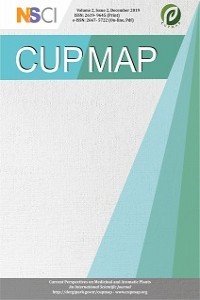Analysis of Mineral Compound of Plant Anthemis pseudocotula Boiss with Different Solvents by Ion Chromatography
Analysis of Mineral Compound of Plant Anthemis pseudocotula Boiss with Different Solvents by Ion Chromatography
Anthemis, Mineral Compound, Plant, Microwave Extraction,
___
- 1. Barbour, E.K., Al Sharif, M., Sagherian, V.K., Habre, A.N., Talhouk, R.S., and Talhouk, S.N., 2004. Screening of selected indigenous plants of Lebanon for antimicrobial activity. Journal of Ethnopharmacology, 93 (1), 1–7.
- 2. Basta, N.T. and Tabatabai, M.A., 1991. Determination of total metals in sewage sludges by ion chromatography. Journal of Environmental Quality, 20, 79–88.
- 3. Bremer, K. and Humphries, C.J., 1993. Generic monograph of the Asteraceae-Anthemideae. Bulletin of the natural History Museum. Botany series, 23 (2), 71–177.
- 4. Bremer, K., 1994. Portland, Oregon: Timber Press. Asteraceae. Cladistics and classification.
- 5. Butnariu, M., Bostan, C., and Samfira, I., 2012. Determination of mineral contents and antioxidant activity in some plants that contain allelochemicals of Banat region (western Romania). Studia Universitatis ‘Vasile Goldis’ Arad, Seria Stiintele Vietii, 22 (January 2014), 95–100.
- 6. Cataldi, T.R.I., Margiotta, G., Del Fiore, A., and Bufo, S.A., 2003. Ionic content in plant extracts determined by ion chromatography with conductivity detection. Phytochemical Analysis, 14 (3), 176–183.
- 7. El Khatib, W., Youssef, B., Bunel, C., and Mortaigne, B., 2003. Fireproofing of polyurethane elastomers by reactive organophosphonates. Polymer international, 52 (1), 146–152.
- 8. Indrayan, A.K., Sharma, S., Durgapal, D., Kumar, N., and Kumar, M., 2005. Determination of nutritive value and analysis of mineral elements for some medicinally valued plants from Uttaranchal. Current Science, 89 (7), 1252–1255.
- 9. Javidnia, K., Miri, R., Kamalinejad, M., Sarkarzadeh, H., and Jamalian, A., 2004. Chemical composition of the essential oils of Anthemis altissima L. grown in Iran. Flavour and fragrance journal, 19 (3), 213–216.
- 10. Johnson, C.M. and Ulrich, A., 1959. Analytical methods for use in plant analysis. Bulletin of the California Agricultural Experiment Station.
- 11. Karioti, A., Skaltsa, H., Kaiser, M., and Tasdemir, D., 2009. Trypanocidal, leishmanicidal and cytotoxic effects of anthecotulide-type linear sesquiterpene lactones from Anthemis auriculata. Phytomedicine, 16 (8), 783–787.
- 12. Malone, M., Herron, M., and Morales, M.A., 2002. Continuous measurement of macronutrient ions in the transpiration stream of intact plants using the meadow spittlebug coupled with ion chromatography. Plant Physiology, 130 (3), 1436–1442.
- 13. Masson, P., De Raemaeker, F., and Bon, F., 2005. Quality control procedures for chloride and nitrate ions analysis in plant samples by ion chromatography. Accreditation and Quality Assurance, 10 (8), 439–443.
- 14. Russo, V.M. and Karmarkar, S. V., 1998. Water extraction of plant tissues for analysis by ion chromatography. Communications in Soil Science and Plant Analysis, 29 (3–4), 245–253.
- 15. Saroglou, V., Dorizas, N., Kypriotakis, Z., and Skaltsa, H.D., 2006. Analysis of the essential oil composition of eight Anthemis species from Greece. Journal of Chromatography A, 1104 (1–2), 313–322.
- 16. Saupi, N., Zakaria, M.H., and Bujang, J.S., 2009. Analytic chemical composition and mineral content of yellow velvetleaf (Limnocharis flava L. Buchenau)’s edible parts. Journal of Applied Sciences, 9 (16), 2969–2974.
- 17. Schalm, O.W., Jain, N.C., and Carroll, E.J., 1975. Material and methods for the study of blood In: veterinary haematology. Lea & Febiger Publ. Philadelphia. Pp. 47 – 50
- 18. Vučković, I., Vujisić, L., Vajs, V., Tešević, V., Macura, S., Janaćković, P., and Milosavljević, S., 2006. Sesquiterpene lactones from the aerial parts of Anthemis arvensis L. Biochemical Systematics and Ecology, 34 (4), 303–309.
- 19. Zhou, X.N., Wang, L.Y., Chen, M.G., Wu, X.H., Jiang, Q.W., Chen, X.Y., Zheng, J., and Jürg, U., 2005. The public health significance and control of schistosomiasis in China – then and now. Acta tropica, 96 (2–3), 97–105.
- ISSN: 2619-9645
- Yayın Aralığı: Yılda 2 Sayı
- Başlangıç: 2018
- Yayıncı: Nazım ŞEKEROĞLU
Ethnobotanical Survey of Some Plants Used in Tessala Region, Algeria
Bellifa NAZIM, Toumi HOUARI, Benhaddou ISMAIL
A Study on Antioxidant and Antimicrobial Activity of Ferulago galbanifera Species
Alican Bahadır SEMERCİ, Melek GÜLER, Kenan TUNÇ
Economically Important Sage Species from Turkey: Salvia fruticosa Mill. and S. aramiensis Rech fil.
Holem H.BALAKY, Eyyüp KARAOĞUL, Ertuğrul ALTUNTAŞ, Alaa Taha Younis HAMMADI, Ali Mala Khedir GALALAEY, Mehmet Hakkı ALMA
Abolfazl JAFARI-SALES, Mehrdad PASHAZADEH
Kusum SAI, Hari Prasad DEVKOTA, Rashmi THAPA, Prakash POUDEL, Khem Raj JOSHI
The Efficiency of BIOAPIFIT® Wound Care Ointment in the Treatment of Venous Ulcers
Višnja OREŠČANIN, Zrinka MIHALIĆ, Josipa RODIĆ, štefica FINDRI GUŠTEK
